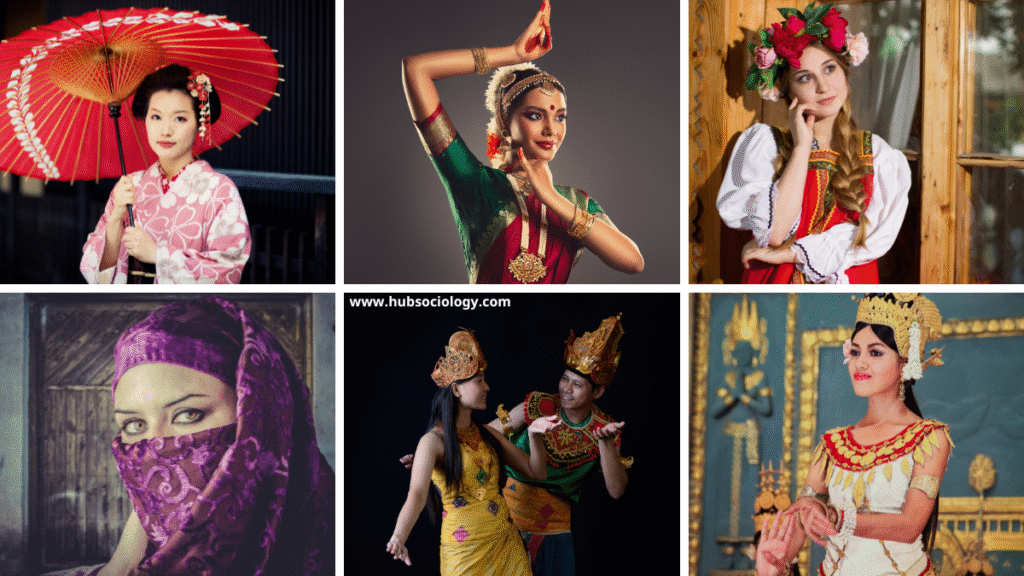Introduction on Globalisation and Cultural Changes
Globalisation, one of the most debated phenomena of the late 20th and 21st centuries, is not limited to economic integration or political interdependence. It is equally a cultural process that redefines identities, traditions, and social practices across the globe. The shrinking of time and space through advanced communication, technology, and transportation has enabled the constant interaction of diverse cultures. From food, fashion, and entertainment to language, religion, and lifestyles, globalisation has deeply influenced cultural norms. In sociology, this intersection of globalisation and culture is studied as a dynamic relationship of homogenisation, hybridisation, resistance, and identity negotiation.
This article critically examines globalisation and cultural changes in the sociological aspect by focusing on the processes, theoretical perspectives, implications, and challenges of global cultural transformations.

Table of Contents
Globalisation and Cultural Changes: Conceptual Clarification
A society’s common values, beliefs, customs, activities, and material possessions are referred to as its culture. It provides individuals with identity and shapes collective life. Simply put, globalization is the strengthening of international social relationships that connect far-flung places in such a way that events far away influence local affairs.
In sociological terms, globalisation and culture interact in two major ways:
- Cultural Homogenisation – The spread of global consumer culture, largely influenced by Western countries, leading to similarities in lifestyle, media consumption, and fashion worldwide.
- Cultural Heterogenisation – The simultaneous strengthening of local cultural identities, often as resistance to global influence.
Thus, cultural change under globalisation is not a unidirectional process; it is dialectical, involving both blending and resistance.
Theoretical Perspectives on Globalisation and Cultural Change
1. Cultural Imperialism Perspective
This view argues that globalisation leads to the domination of powerful cultures (especially Western or American culture) over weaker ones. Western values are disseminated around the world by Hollywood, international fast-food chains, multinational enterprises, and social media platforms. Critics argue this undermines indigenous traditions and languages, producing cultural uniformity.
2. World-Systems Theory
Immanuel Wallerstein’s world-systems theory highlights how global capitalism creates a core-periphery structure. This reduces cultural sovereignty and fosters dependency by having core nations export their cultural goods to peripheral countries.
3. Hybridisation Perspective
Sociologists such as Jan Nederveen Pieterse emphasise cultural hybridisation, where global and local cultures interact to create something new. Indian Bollywood, for example, keeps its native themes while incorporating aspects of Western pop music. Similarly, McDonald’s adapts its menu in India by serving vegetarian options, creating a “glocalised” product.
4. Anthony Giddens: Disembedding and Re-embedding
According to Giddens, globalization is the process of re-embedding social ties over great distances after they were previously embedded in local contexts. For example, social media friendships connect people across continents, transforming traditional patterns of interaction.
5. Roland Robertson: Glocalisation
Robertson highlights that global and local dynamics are not opposed but intertwined. To stay unique, local cultures modify and reinterpret global customs.
Dimensions of Cultural Change Under Globalisation
1. Language and Communication
English has emerged as a global lingua franca due to globalisation, facilitating international communication but also threatening linguistic diversity. Many regional languages are declining as younger generations adopt English or other dominant languages for economic mobility.
2. Media and Popular Culture
Global media platforms such as Netflix, YouTube, and Instagram spread cultural products across borders. Examples of cross-border cultural ventures include anime, K-pop, and Hollywood blockbusters. At the same time, globalisation allows local cultural products to gain worldwide audiences (e.g., Indian yoga, Japanese sushi, Korean dramas).

3. Food and Lifestyle
Global fast-food chains (McDonald’s, KFC, Starbucks) have transformed eating habits worldwide, contributing to cultural homogenisation. Yet, they adapt menus to local tastes, showing hybridisation. Similarly, lifestyle changes such as gym culture, Western fashion, and online dating reflect global influence.
4. Religion and Belief Systems
New spiritual movements and interreligious discussion are encouraged by globalization. However, it also generates religious fundamentalism as a reaction against perceived cultural imperialism. For instance, globalisation has led to both the spread of secular values and the resurgence of traditionalist movements.
5. Identity and Youth Culture
Globalisation deeply influences youth identities. Exposure to global music, fashion, and digital platforms creates a cosmopolitan youth culture. Yet, this often creates a generational gap between traditional elders and globally influenced youth.
6. Migration and Diaspora Communities
Migration enables the exchange of cultures, leading to multicultural societies. Diaspora cultures create hybrid identities by preserving cultural customs and assimilating into host societies. This dual cultural approach is seen in Chinese communities in the US and Indian communities in the UK.
Positive Cultural Impacts of Globalisation
- Cultural Exchange and Enrichment – Individuals gain access to new cultural experiences, cuisines, music, and art forms.
- Promotion of Tolerance – Globalisation exposes people to diversity, fostering acceptance of multiculturalism.
- Revival of Indigenous Cultures – Global interest in yoga, Ayurveda, and martial arts shows how globalisation can promote local traditions globally.
- Empowerment through Technology – Social media gives marginalised voices a global platform, enabling cultural resistance and identity assertion.
Negative Cultural Impacts of Globalisation
- Cultural Homogenisation – Global consumerism and Westernisation erode local traditions, values, and languages.
- Loss of Identity – Individuals, particularly youth, may feel alienated from their roots due to global influences.
- Commodification of Culture – Cultural symbols and practices are commercialised for profit, stripping them of original meaning (e.g., yoga as a fitness trend).
- Cultural Conflicts – The clash between global modernity and traditional values can generate tensions within societies.
Case Studies on Globalisation and Cultural Changes
1. India
In India, globalisation has reshaped urban lifestyles. Bollywood now integrates Western music, fashion brands dominate youth culture, and IT-driven cosmopolitanism connects Indians to global networks. Yet, regional languages, folk traditions, and local cuisines continue to thrive, showing glocalisation.
2. Japan
Japan has exported anime, manga, and J-pop all over the world while also absorbing Hollywood entertainment and Western fast-food culture. This mutual exchange illustrates cultural hybridisation.
3. Middle East
Globalisation has introduced modern lifestyles in Middle Eastern societies, yet cultural resistance through religious conservatism also strengthened. Women’s roles, family norms, and dress codes reflect tensions between global and local values.
Challenges in Analysing Cultural Globalisation
- Ethnocentrism – Western academic perspectives often dominate the study of globalisation, underestimating non-Western cultural contributions.
- Unequal Power Relations – Cultural exchanges are rarely equal; dominant cultures impose more influence than others.
- Identity Crisis – Migrants and youth may face confusion in balancing global modernity with traditional values.
Conclusion on Globalisation and Cultural Changes
Globalisation and cultural changes, when analysed sociologically, reveal a complex and multidimensional process. It is neither purely homogenising nor entirely fragmenting; rather, it is dialectical, producing hybrid cultures and redefined identities. While globalisation promotes cultural enrichment and cosmopolitanism, it simultaneously threatens cultural diversity and local traditions.

From the sociological lens, globalisation is best understood as a process of negotiation between the global and the local—between forces of integration and forces of resistance. The future of cultural globalisation lies not in uniformity but in hybridity, where multiple identities coexist, adapt, and evolve. Ultimately, societies must strive to balance global interconnectedness with the preservation of cultural diversity, ensuring that globalisation becomes a source of mutual enrichment rather than cultural erasure.
Do you like this this Article ? You Can follow as on :-
Facebook – https://www.facebook.com/hubsociology
Whatsapp Channel – https://whatsapp.com/channel/0029Vb6D8vGKWEKpJpu5QP0O
Gmail – hubsociology@gmail.com
Exam-style questions on Globalisation and Cultural Changes
5 Marks Questions on Globalisation and Cultural Changes (Short Answer)
- Define cultural homogenisation with an example.
- What is meant by cultural hybridisation in the context of globalisation?
- Mention two ways in which globalisation has influenced youth culture.
- What does Roland Robertson mean by “glocalisation”?
- Write two negative impacts of globalisation on culture.
- Give one example of cultural change in India due to globalisation.
- Explain briefly the concept of cultural imperialism.
- Mention one way in which globalisation affects religion and belief systems.
- Define commodification of culture with one example.
- State any two positive cultural impacts of globalisation.
10 Marks Questions on Globalisation and Cultural Changes (Medium Answer)
- Explain how globalisation has influenced food and lifestyle with examples.
- Discuss Anthony Giddens’ concept of disembedding and re-embedding in cultural globalisation.
- How has media and popular culture transformed under globalisation?
- Examine the impact of globalisation on language and communication.
- Analyse the role of migration and diaspora in shaping cultural changes.
- Discuss the challenges of analysing cultural globalisation from a sociological perspective.
- With examples, explain how glocalisation works in cultural practices.
- Discuss the positive and negative impacts of globalisation on culture.
- Explain the relationship between globalisation and identity formation among youth.
- How does globalisation lead to both cultural exchange and cultural resistance?
15 Marks Questions on Globalisation and Cultural Changes (Long Answer)
- Critically examine the sociological perspectives on globalisation and cultural change (cultural imperialism, hybridisation, world-systems theory).
- Discuss in detail the dimensions of cultural change under globalisation (language, media, food, religion, lifestyle, youth culture, migration).
- Analyse the impact of globalisation on Indian culture with suitable examples.
- “Globalisation is both homogenising and heterogenising in nature.” Explain with sociological arguments.
- Evaluate the positive and negative cultural consequences of globalisation in contemporary society.
- How has globalisation affected traditional values and practices across the world? Illustrate with examples from different regions.
- Discuss the role of global media and consumer culture in shaping cultural change.
- Examine the dialectical relationship between globalisation and cultural identity.
- How does globalisation contribute to both cultural enrichment and cultural loss?
- Critically evaluate the statement: “The future of cultural globalisation lies not in uniformity but in hybridity.”
